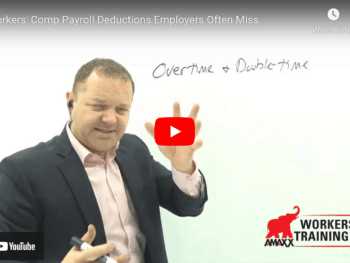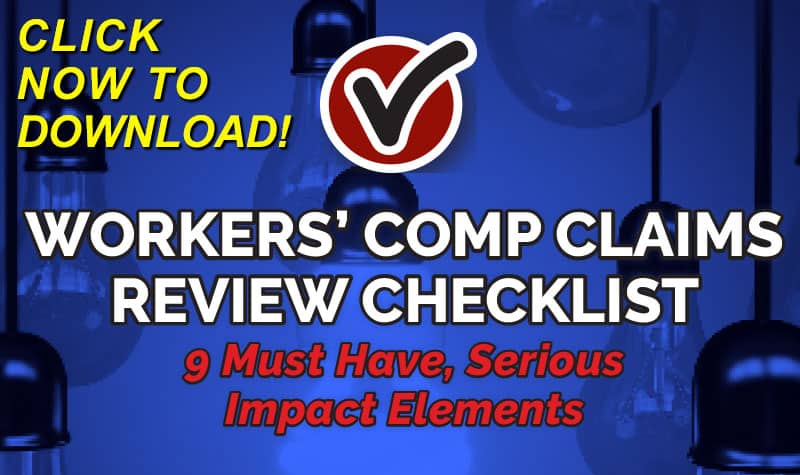Most Workers compensation insurance premiums are generally formulated in five basic methods.
The first method is state insurance commission experience modification programs. The second method is Retrospective Programming, (known as Retros); it is developed by a contractual agreement between an insurance carrier and the insured employer. A third method is the use high retentions. Fourth is Self-funding. In this program the employer pays all losses. The last method reviewed is group or pool funding programs.
Click Link to Access Free PDF Download
“Workers’ Comp Claims Review Checklist: 9 Must-Have, Serious-Impact Elements”
Experience Modification Premium Method:
Experience Modification premiums are developed from, gross payroll, losses reported to the state for the past three years, job classification codes, and application of credits discounts, assessments and penalties derived by the state insurance department.
Gross payroll figures must reflect only the true wages for the employees of the organization. Sort out leased employees, contractors, vendors, and sub-contractor persons working. It is necessary for the employer to transfer risk back to these suppliers. Obtain Certificates of Insurance from these suppliers naming the employer as an also insured. Use contractual hold-harmless and indemnification clauses in all contracts with the supplying organization.
Proper employee Job classification coding is the next step. The National Council on Compensation Insurance (NCCI) has developed the codes used by most states. The states not using NCCI codes have developed their own lists. Most job codes reflect the overall business. Hence multiple codes could apply for the same type job. Each could have a different rate. Furnish the agent, broker, risk manager, or underwriter with complete job descriptions. Detail all tasks and hours. A few NCCI job class code examples are: 3632 machine shop repair employees, 8810 clerical persons, and 5022 masonry workers
North Carolina currently has the class code rates and group rates for:
Machine Shop coded 3632 has a basic rate of $2.69 and a group rate of $5.58
Clerical coded 8810 have a basic rate of $0.21 and a group fund rate of $0.44.
Masonry coded 5022 has a basic rate of $5.79 and a group fund rate of $12.02
In addition to the basic premium states assign the modifier code. This is developed by the state insurance department using job classification codes, loss experiences, potential discounts, credits, penalties or assessments. Currently North Carolina’s MOD rate is 11.65 as of April 1, 2014.
The final step is the application of discounts, penalties and assessments. Credits are determined based on many potential factors. A few are: employer safety programs, substance abuse programs, low loss experience. Penalties or assessments can be due to poor loss experience, poor operational conditions, OSHA fines and many other causes.
The final calculation formula is:
(Job Classification code rate) X (MOD Rate) X (Gross Payroll) + or – (adjustments) = Premium.
Assuming the net Gross payroll is $100,000.00 and the employer qualifies for a 10% discount, the numbers for the Machine Shop premium would be:
$2.69 times 11.65 =31.00 times 100,000.00 =$ 3100.00 – $310.00 = $2,700.00 as final premium.
Carrier earnings cause impacts on premiums. Good earning years from carrier investments or income, may allow them to deviate from the state MOD. They may grant premium reductions based on a percentage of those earnings. During lean earning years, or years with lost profit, carriers more than likely will charge full premium value.
Retrospective Premium Method:
Retrospective Rating (AKA Retros) premiums are derived by contractual agreement between the insurance carrier and the employer. Simply stated the employer deposits a sum of money with the insurance carrier. The carrier uses the funds to pay the employer losses and expenses. As the deposits are used the carrier makes adjustments. Final adjustments begin 3 months after the policy expires and continue periodically until the losses are fully paid or funded.
This program is only available with an insurance carrier. It may limit the employer’s ability to change carriers. Employers, with financial stability, who have a loss history, who maintain valid and consistent claim data, have large workers compensation premiums, and have better than average loss experience are the best type of employer to consider this program.
Retention Premium Method:
An employer may reduce premium cost by accepting a retention program. This acts like a deductible. In this program the employer processes the loss up to a certain dollar value, time frame or severity. Great care must be taken not to miss the reporting time frames and dollar values as coverage issues could develop. Severe injury cases, fatalities and contested cases should always be turned over to the carrier at once. The carrier will request payment of the retention if and when it to pay the loss.
Self-Insured Program:
Self -Insured programs require permission from the state, and sufficient financial capacity to pay losses. Qualified loss technicians need to administer the cases. Employers must comply with workers compensation reporting. It is recommended that a surplus insurance policy be obtained for losses exceeding any amount the employer decides as a cap for exposure. Severe injury, fatalities, and contested cases should be re-insured.
Pool and Group Premium Methods:
Pool and Group funding is derived from premium assessments to each member. Many variations are in use to assess these dollars. Some follow usual premium developments discussed earlier. Others ask for pre-funding and make adjustments as the funds are used. There may be assessments for bad loss experience. Conversely good experiences are rewarded with discounts. When applying to a group or pool it is imperative that the employer is fully cognizant of all the pool’s requirements, operations and how it impacts the individual member.
Claim Administrators:
Self-insured employers and groups or pools, generally employ Third Party Administrators. (TPA) The TPA is made up of professional claim persons and operates the same as an insurance carrier claim department. All rules, regulations and law requirements apply.
The TPA is often required to get the self-insured employer, and the group or pool to approve settlements of losses. This may even be required for an individual pool or group member. TPAs also perform regular loss reports. It may be to an individual member, the ranking board of the group or pool. Such reports cover loss values, nature of losses, expected outcomes, steps being taken to disposition that is prompt, equitable and in compliance with the law. There can be full claim reviews as well.
Some pitfalls for pool or group insurance may be poor of cooperation among members, financial stabilities of members, poor loss experience of one or more of the members, and slow responses to uniform desires by some members. The entire group or pool membership can be assessed for overall problems developed during operations.
Assessments generally arise from huge losses, loses to the groups assets, director error and omission, as well as failure of the group or pool to perform some legal requirement.
Exempt Employees and Employers:
Explore employers or employees exemptions from the workers compensation law.
A few exemptions are:
Officers and Directors
Sole proprietors
Household Domestic Employees
Casual Employees
Real Estate Persons
Volunteer Persons
Employees covered under Federal Laws
Family members in the same household caring for others in the family
Franchise owners
Claim Audits:
Claim audits can be used to impact premiums. Two months prior to renewal, obtain a full loss run from the insurance carrier. Study the run to be sure the claims are correctly reported and classified paid and reserved. Look for files that should be closed. When concerns are noted ask the insurance claim department to provide a full review and explanation. Resolve all differences and have the loss run corrected before it goes to the underwriters for renewal.
Using professional claim auditors not only allows for loss evaluations, it can assess the claim unit personnel experience, efficiency of operation, and adherence to best practices.
Summation:
In summary, the following suggestions could help reduce workers compensation premiums.
1. Clarify gross payroll so it only reflects true employees.
2. Transfer risk to Lessors, Vendors, Contractors, and sub-contracts through
Certificates of Insurance and Hold-Harmless clauses.
3. Check that employees are properly classified for state MOD calculation.
4. Look for all credits and discounts available from carriers and the state.
5. When considering a Retrospective Program, use fully trained and experienced, underwriters,
Insurance brokers and risk managers.
6. Fully explore all pros and cons for self-insurance or in joining industry groups or pools.
7. If a penalty or assessment is in effect, seek ways to correct the shortcomings that caused it.
8. Perform Claim Audits prior to renewal.
Author Michael B. Stack, CPA, Principal, Amaxx Risk Solutions, Inc. is an expert in employer communication systems and part of the Amaxx team helping companies reduce their workers compensation costs by 20% to 50%. He is a writer, speaker, and website publisher. www.reduceyourworkerscomp.com. Contact: mstack@reduceyourworkerscomp.com.
©2014 Amaxx Risk Solutions, Inc. All rights reserved under International Copyright Law.
WORK COMP CALCULATOR: http://www.LowerWC.com/calculator.php
MODIFIED DUTY CALCULATOR: http://www.LowerWC.com/transitional-duty-cost-calculator.php
WC GROUP: http://www.linkedin.com/groups?homeNewMember=&gid=1922050/
SUBSCRIBE: Workers Comp Resource Center Newsletter
Do not use this information without independent verification. All state laws vary. You should consult with your insurance broker, attorney, or qualified professional.












Concerning the example for North Carolina, what is or how do I find this information for another state–particularly Georgia? Or can you give me this same example using the class code, MOD rate, etc. for Georgia?
Thanks in advance!